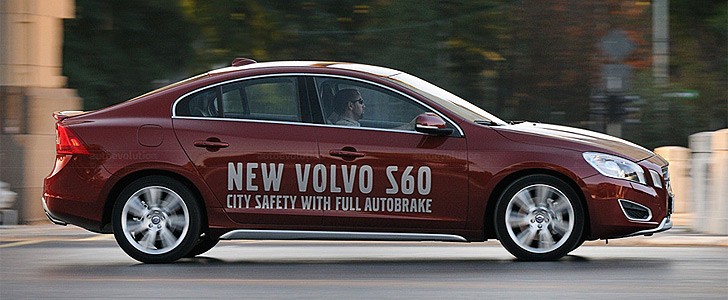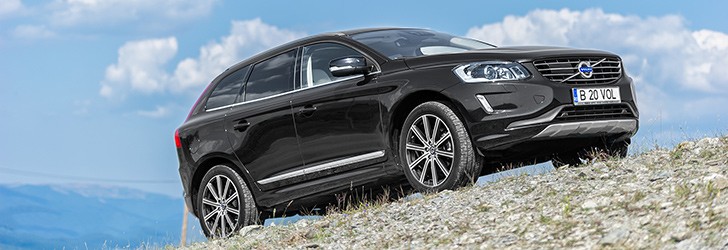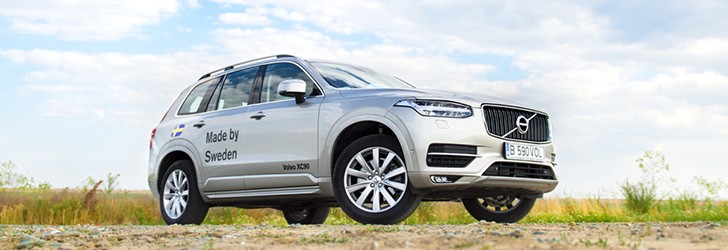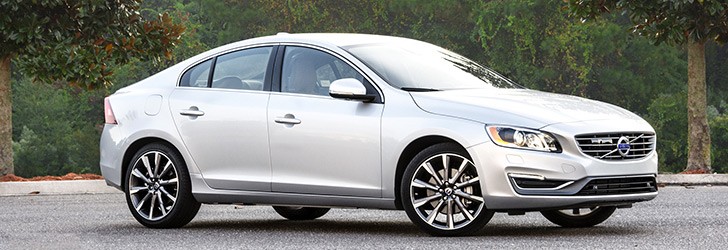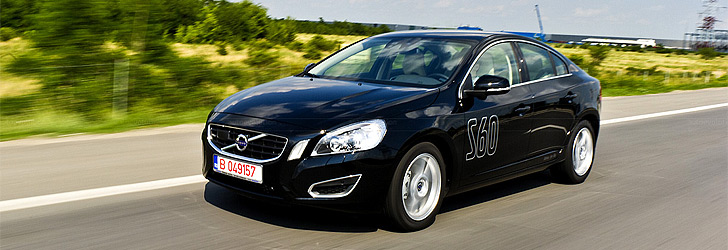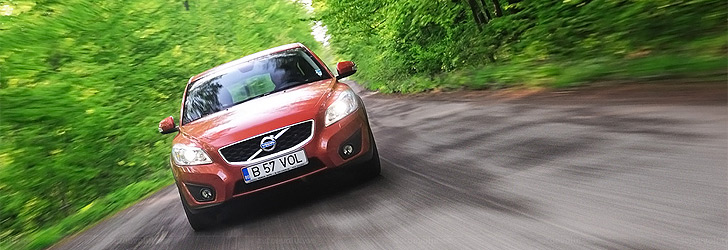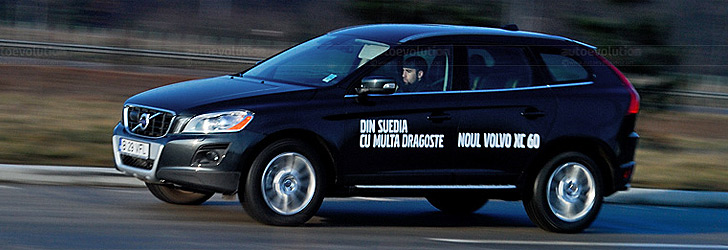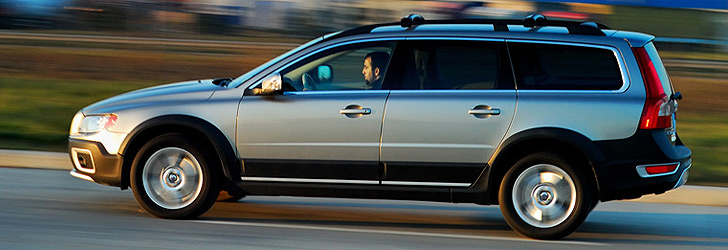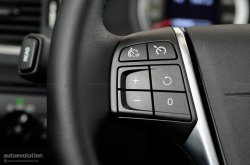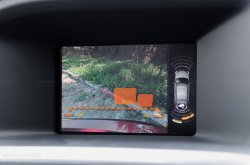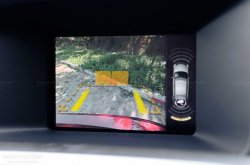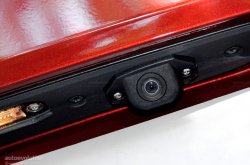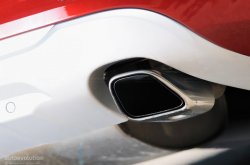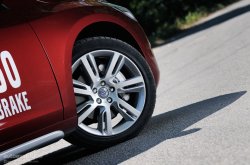VOLVO S60 Review
OUR TEST CAR: VOLVO S60 2.0T
As many of you remember, up until the late 1990s Volvo was known for three things mostly: safety, beige station wagons and kitchen cabinet aerodynamics. Fortunately, things began to change towards the end of the decade, after Peter Horbury finally got his way to revamp the whole Volvo lineup when it comes to design.
The 1995 S40 was built on the same platform as the Mitsubishi Carisma, but its look didn't inherit any Mitsubishi nor any old Volvo design cues. The first production Volvo to use the now-trademarked "shoulder lines", it represented the dawn of a new design language for the company. Still, the first S40 was just a small preview of what was about to come at Volvo.
The real groundbreaking departure from the angular design cues of older Volvos was the first generation of the S80, born in 1998, which then lent some its genes to the smaller S60 in 2000. Peter Horbury's design revolution was therefore almost complete, especially since the S60 was marketed as heralding a "Revolvolution". This made-up word might seem as a hollow marketing gimmicks for some, but a reality for (most) Volvo aficionados.
Ten years later, the "revolvoed" S60 has reached its second generation, and it's yet again on the verge of reinventing what the world thinks about Volvo design. Of course, the model is not alone in this, as the first exponent of yet another new design language at Volvo is the XC60, a car which we also tested last year.
Getting back to the new S60, let's just say that a person traveling through time from the early 1990s would never suspect this is a Volvo. Let's remember that back then even Volvo concept cars were angular. On top of the design departure from traditional Volvo styling, the new S60 is also the first car from the Swedish stable to finally sport an almost completely new engine line-up.
We jumped at the chance to see what the new car was capable of, choosing the all-new two-liter direct injection GTDI engine, paired to Volvo's all-new twin-clutch sequential transmission. Read on to find out what we learned from our experience behind the wheel.
As we also mentioned in the previous chapter, the second generation of the Volvo S60 represents the first design breakthrough for Volvo sedans in over a decade. Penned under the supervision of ex-Mercedes-Benz (and Volvo, for that matter) designer, Steve Mattin, the car's main lines are very much based on the Volvo S60 Concept, which had the wraps taken off of it at the 2009 Detroit Auto Show.
We don't know about you guys, but from our view Steve Mattin managed to create one of the most beautiful and sporty-looking Volvos in a long, long time. Not since the drooling over Simon Templar's P1800 has the world been ready to drop jaws about the sexiness of a Volvo's lines.
As in most sexy cars, the beauty of the new S60 lays in the details. Let's start with the front end, which sports a snout worthy of a crossbreed between a British GT and a Volvo XC60 – which, coincidentally, was also penned by Steve Mattin. Just like the aforementioned compact crossover, the headlights are much more aggressive than on older Volvos, with that aggression being encouraged even more by the daylight driving LED lights, which follow the V-line of the engine hood and sit right between the regular headlights.
The side view is very much in tone with the increasingly trendy coupe roofline, while the swooping character line gives the S60 even better proportions than the C70, which is an actual coupe (OK, and convertible). The front overhang is a bit too large for our taste, but doesn't retract much from the car's overall GT shape.
At the rear we are met with some of the most spectacular Volvo L-shaped taillights, which almost tie with the ones from the XC60 as far as character goes. The Peter Horbury-introduced "shoulders" are still visible, making for a pretty cool connection with somewhat older Volvos. All in all, we think the S60 is probably the most beautiful Volvo in years.
Unlike the exterior, the S60's interior is not exactly groundbreaking as far as design goes. It would have been if it wasn't for... oh, just about every other Volvo since the second-generation S40 and V50 onwards having almost the same center console. We are of course talking about the "floating" design of the center console, but we might as well add the steering wheel, the dashboard, the interior door panels, the seats, etc.
No, they're not exactly identical, but we think Volvo's interior designers might have put a little too much thought into the whole "family traits" design thing. Other than that, the S60's interior actually doesn't look half bad.
So, even though nowadays it's almost as common on Volvos as the symbol of Mars, the "floating" center console looks as fresh as ever, and the space it frees up behind it can be put to good use. As usual, the ergonomics are top notch, with a single small exception. There is no fancy iDrive-like jack of all trades "God button", so the controls for the onboard computer have to sometimes be shared between the steering wheel and the center console.
Other than that, the interior quality is so good you'd think you jumped into a much more expensive vehicle. In our test car we had a high-quality black leather upholstery, real aluminium inserts and a pretty interesting-looking material for the center console.
As far as the interior space goes, we were originally inclined to think the curved roof line might mean it has poor headroom. Turns out we were half right, since only really tall rear passengers may experience some problems with their heads trying to stick through the roof. It's not actually cramped in there or anything, but comparing with other Volvo sedans from the past, the four-door-coupe look has really brought some negative bits as well.
Quite possibly the worst aspect of the sporty design in the new Volvo S60 is the size of the luggage compartment. With only 380 liters (13.4 cubic feet) at its disposal, the trunk is just a tiny bit bigger than one from a compact car like the VW Golf, or better yet, the Audi A3. The good news from this point of view is that it's easily accessible and the rear bench is foldable in a 60:40 fashion.
As we previously mentioned, our test car was fitted with a brand new engine and a brand new transmission, which is also Volvo's first ever double-clutch sequential. The direct injection two-liter four-banger under the hood also benefits from a turbocharger setup that helps the unit achieve 203 horsepower and no less than 300 Nm (221.3 lb ft) of torque from as low as 1750 rpm, all the way to 4500 rpm.
Unfortunately, even though on paper this should have translated into a pretty good fuel economy for a gasoline-powered car, it wasn't exactly the case during our test drive, especially in a busy city's traffic. Volvo hasn't released the city fuel consumption figures for the S60 yet, but we're pretty sure they are going to be quite a bit more optimistic than what we achieved during our test drive.
Driving with a heavier right foot and putting those 300 Nm (221.3 lb ft) of torque to good use whenever we drove off from a stop light we achieved no less than 16 liters per 100 kilometers (US 14.7 mpg). A more mellow driving style and less traffic sent the average fuel consumption to about 13.5 liters per 100 km (US 17.4 mpg), which is still quite a bit more than we would have expected, especially since it required a driving compromise.
Of course, our test car was practically brand new and with very little mileage on it when we took it for a spin, so after a couple of thousand kilometers the fuel economy may be a bit better, but the 2.0T engine with Powershift is definitely not the fuel sipper of the S60 range.
As far as the everyday city behavior goes, the new S60 handled like a breeze. The overall visibility is above average, while parking jobs were helped by an array of front and rear parking sensors. On top of that, our test car was also fitted with a rearview camera equipped with a highly intelligent assist system. Apart from "showing" the exact direction at which the front wheels are pushing the car to, the aforementioned system can technically guess what objects are nearing the car from behind. Pretty cool stuff!
All in all, if we would ignore the rather high fuel consumption in stop-and-go traffic and the pretty small luggage compartment, the Volvo S60 2.0T is a pretty good compromise car for the city, even though its main attributes are to be experienced best on the open road.
With the right foot firmly planted on the accelerator pedal, the S60 2.0T with Powershift can move its handsome body from zero to 100 km/h (62 mph) in 8.2 seconds. While for some that may seem a very good time, it fails to win any awards because of a few simple reasons.
First of all, considering the 203 horsepower and 300 Nm (221.3 lb ft) – or even 320 Nm (236 lb ft) with overboost - lightning fast gear changes from the double-clutch sequential transmission and the car's 1570 kg (3461 pounds), we would have expected it to be a bit faster as far as the feelings go. As it turns out, the double-clutch gearbox is by far not as fast or as responsive as a Volkswagen's DSG or a Porsche's PDK, while the car isn't exactly in the featherweight category.
Second of all, if we compare these acceleration figures with its direct competitors, the plot might thicken. The Mercedes-Benz C 200 CGI we tested a while back manages an equal 0-100 km/h (62 mph) time with 16 hp and 30 Nm (22.1 lb ft) less than the 2.0 GTDI-engined Volvo S60. Not to mention the fact that the Benz also has an old-school automatic transmission with a torque converter instead of a latest generation double-clutch sequential.
Both BMW and Audi sport lower-powered four-cylinder units that achieve similar or even better acceleration times as well, so the S60 2.0T is not as efficient on paper as its main competitors. In real life driving the situation is not as grim as it may sound though, mainly thanks to the torque available for such a wide range of rpm.
The transmission can be a bit inexact in its gear choice from time to time, while the kickdown function is not as fast as you'd expect from a double-clutch sequential. On the other hand, the new S60 is simply a joy when driven on winding roads, even when going to the limit.
Equipped with a virtual torque vectoring system that can brake the inside wheel when tackling corners with higher-than-usual speeds, our test car really flew through the curves. The "torque steer" experienced with other high-powered front-wheel drive cars was kept at a minimum using this contraption, while the overall balance of the car was much, much better than we had expected. As far as driving pleasure goes, the S60 2.0T is right up there with the big boys in this league, something that we would have never expected from Volvo.
During our open road driving section we managed a fuel consumption between 7.6 liters per 100 km (US 31 mpg) while using the intelligent cruise control system and average speeds, while in a more dynamic driving session it grew to about 11.5 liters per 100 km (US 20.5 mpg). Both figures are somewhat normal for this kind of performance, but they're nothing to brag about considering the aforementioned competitors. All in all, despite the obvious... let's say moral setbacks, the S60 2.0T provided us with quite a pleasant surprise as far as handling on the open road goes.
The 1995 S40 was built on the same platform as the Mitsubishi Carisma, but its look didn't inherit any Mitsubishi nor any old Volvo design cues. The first production Volvo to use the now-trademarked "shoulder lines", it represented the dawn of a new design language for the company. Still, the first S40 was just a small preview of what was about to come at Volvo.
The real groundbreaking departure from the angular design cues of older Volvos was the first generation of the S80, born in 1998, which then lent some its genes to the smaller S60 in 2000. Peter Horbury's design revolution was therefore almost complete, especially since the S60 was marketed as heralding a "Revolvolution". This made-up word might seem as a hollow marketing gimmicks for some, but a reality for (most) Volvo aficionados.
Ten years later, the "revolvoed" S60 has reached its second generation, and it's yet again on the verge of reinventing what the world thinks about Volvo design. Of course, the model is not alone in this, as the first exponent of yet another new design language at Volvo is the XC60, a car which we also tested last year.
Getting back to the new S60, let's just say that a person traveling through time from the early 1990s would never suspect this is a Volvo. Let's remember that back then even Volvo concept cars were angular. On top of the design departure from traditional Volvo styling, the new S60 is also the first car from the Swedish stable to finally sport an almost completely new engine line-up.
We jumped at the chance to see what the new car was capable of, choosing the all-new two-liter direct injection GTDI engine, paired to Volvo's all-new twin-clutch sequential transmission. Read on to find out what we learned from our experience behind the wheel.
As we also mentioned in the previous chapter, the second generation of the Volvo S60 represents the first design breakthrough for Volvo sedans in over a decade. Penned under the supervision of ex-Mercedes-Benz (and Volvo, for that matter) designer, Steve Mattin, the car's main lines are very much based on the Volvo S60 Concept, which had the wraps taken off of it at the 2009 Detroit Auto Show.
We don't know about you guys, but from our view Steve Mattin managed to create one of the most beautiful and sporty-looking Volvos in a long, long time. Not since the drooling over Simon Templar's P1800 has the world been ready to drop jaws about the sexiness of a Volvo's lines.
As in most sexy cars, the beauty of the new S60 lays in the details. Let's start with the front end, which sports a snout worthy of a crossbreed between a British GT and a Volvo XC60 – which, coincidentally, was also penned by Steve Mattin. Just like the aforementioned compact crossover, the headlights are much more aggressive than on older Volvos, with that aggression being encouraged even more by the daylight driving LED lights, which follow the V-line of the engine hood and sit right between the regular headlights.
The side view is very much in tone with the increasingly trendy coupe roofline, while the swooping character line gives the S60 even better proportions than the C70, which is an actual coupe (OK, and convertible). The front overhang is a bit too large for our taste, but doesn't retract much from the car's overall GT shape.
At the rear we are met with some of the most spectacular Volvo L-shaped taillights, which almost tie with the ones from the XC60 as far as character goes. The Peter Horbury-introduced "shoulders" are still visible, making for a pretty cool connection with somewhat older Volvos. All in all, we think the S60 is probably the most beautiful Volvo in years.
Unlike the exterior, the S60's interior is not exactly groundbreaking as far as design goes. It would have been if it wasn't for... oh, just about every other Volvo since the second-generation S40 and V50 onwards having almost the same center console. We are of course talking about the "floating" design of the center console, but we might as well add the steering wheel, the dashboard, the interior door panels, the seats, etc.
No, they're not exactly identical, but we think Volvo's interior designers might have put a little too much thought into the whole "family traits" design thing. Other than that, the S60's interior actually doesn't look half bad.
So, even though nowadays it's almost as common on Volvos as the symbol of Mars, the "floating" center console looks as fresh as ever, and the space it frees up behind it can be put to good use. As usual, the ergonomics are top notch, with a single small exception. There is no fancy iDrive-like jack of all trades "God button", so the controls for the onboard computer have to sometimes be shared between the steering wheel and the center console.
Other than that, the interior quality is so good you'd think you jumped into a much more expensive vehicle. In our test car we had a high-quality black leather upholstery, real aluminium inserts and a pretty interesting-looking material for the center console.
As far as the interior space goes, we were originally inclined to think the curved roof line might mean it has poor headroom. Turns out we were half right, since only really tall rear passengers may experience some problems with their heads trying to stick through the roof. It's not actually cramped in there or anything, but comparing with other Volvo sedans from the past, the four-door-coupe look has really brought some negative bits as well.
Quite possibly the worst aspect of the sporty design in the new Volvo S60 is the size of the luggage compartment. With only 380 liters (13.4 cubic feet) at its disposal, the trunk is just a tiny bit bigger than one from a compact car like the VW Golf, or better yet, the Audi A3. The good news from this point of view is that it's easily accessible and the rear bench is foldable in a 60:40 fashion.
As we previously mentioned, our test car was fitted with a brand new engine and a brand new transmission, which is also Volvo's first ever double-clutch sequential. The direct injection two-liter four-banger under the hood also benefits from a turbocharger setup that helps the unit achieve 203 horsepower and no less than 300 Nm (221.3 lb ft) of torque from as low as 1750 rpm, all the way to 4500 rpm.
Unfortunately, even though on paper this should have translated into a pretty good fuel economy for a gasoline-powered car, it wasn't exactly the case during our test drive, especially in a busy city's traffic. Volvo hasn't released the city fuel consumption figures for the S60 yet, but we're pretty sure they are going to be quite a bit more optimistic than what we achieved during our test drive.
Driving with a heavier right foot and putting those 300 Nm (221.3 lb ft) of torque to good use whenever we drove off from a stop light we achieved no less than 16 liters per 100 kilometers (US 14.7 mpg). A more mellow driving style and less traffic sent the average fuel consumption to about 13.5 liters per 100 km (US 17.4 mpg), which is still quite a bit more than we would have expected, especially since it required a driving compromise.
Of course, our test car was practically brand new and with very little mileage on it when we took it for a spin, so after a couple of thousand kilometers the fuel economy may be a bit better, but the 2.0T engine with Powershift is definitely not the fuel sipper of the S60 range.
As far as the everyday city behavior goes, the new S60 handled like a breeze. The overall visibility is above average, while parking jobs were helped by an array of front and rear parking sensors. On top of that, our test car was also fitted with a rearview camera equipped with a highly intelligent assist system. Apart from "showing" the exact direction at which the front wheels are pushing the car to, the aforementioned system can technically guess what objects are nearing the car from behind. Pretty cool stuff!
All in all, if we would ignore the rather high fuel consumption in stop-and-go traffic and the pretty small luggage compartment, the Volvo S60 2.0T is a pretty good compromise car for the city, even though its main attributes are to be experienced best on the open road.
With the right foot firmly planted on the accelerator pedal, the S60 2.0T with Powershift can move its handsome body from zero to 100 km/h (62 mph) in 8.2 seconds. While for some that may seem a very good time, it fails to win any awards because of a few simple reasons.
First of all, considering the 203 horsepower and 300 Nm (221.3 lb ft) – or even 320 Nm (236 lb ft) with overboost - lightning fast gear changes from the double-clutch sequential transmission and the car's 1570 kg (3461 pounds), we would have expected it to be a bit faster as far as the feelings go. As it turns out, the double-clutch gearbox is by far not as fast or as responsive as a Volkswagen's DSG or a Porsche's PDK, while the car isn't exactly in the featherweight category.
Second of all, if we compare these acceleration figures with its direct competitors, the plot might thicken. The Mercedes-Benz C 200 CGI we tested a while back manages an equal 0-100 km/h (62 mph) time with 16 hp and 30 Nm (22.1 lb ft) less than the 2.0 GTDI-engined Volvo S60. Not to mention the fact that the Benz also has an old-school automatic transmission with a torque converter instead of a latest generation double-clutch sequential.
Both BMW and Audi sport lower-powered four-cylinder units that achieve similar or even better acceleration times as well, so the S60 2.0T is not as efficient on paper as its main competitors. In real life driving the situation is not as grim as it may sound though, mainly thanks to the torque available for such a wide range of rpm.
The transmission can be a bit inexact in its gear choice from time to time, while the kickdown function is not as fast as you'd expect from a double-clutch sequential. On the other hand, the new S60 is simply a joy when driven on winding roads, even when going to the limit.
Equipped with a virtual torque vectoring system that can brake the inside wheel when tackling corners with higher-than-usual speeds, our test car really flew through the curves. The "torque steer" experienced with other high-powered front-wheel drive cars was kept at a minimum using this contraption, while the overall balance of the car was much, much better than we had expected. As far as driving pleasure goes, the S60 2.0T is right up there with the big boys in this league, something that we would have never expected from Volvo.
During our open road driving section we managed a fuel consumption between 7.6 liters per 100 km (US 31 mpg) while using the intelligent cruise control system and average speeds, while in a more dynamic driving session it grew to about 11.5 liters per 100 km (US 20.5 mpg). Both figures are somewhat normal for this kind of performance, but they're nothing to brag about considering the aforementioned competitors. All in all, despite the obvious... let's say moral setbacks, the S60 2.0T provided us with quite a pleasant surprise as far as handling on the open road goes.
12
Our VOLVO Testdrives:
Photo gallery (88)
